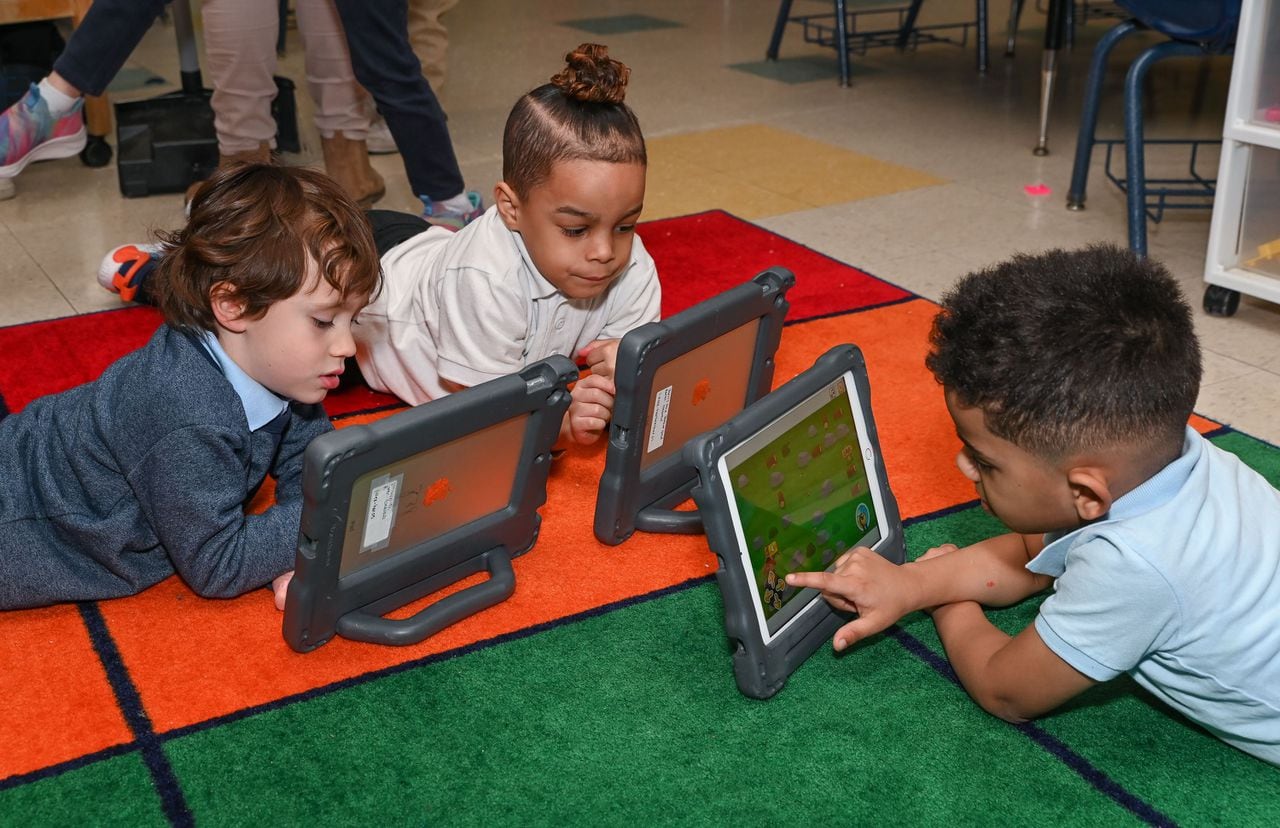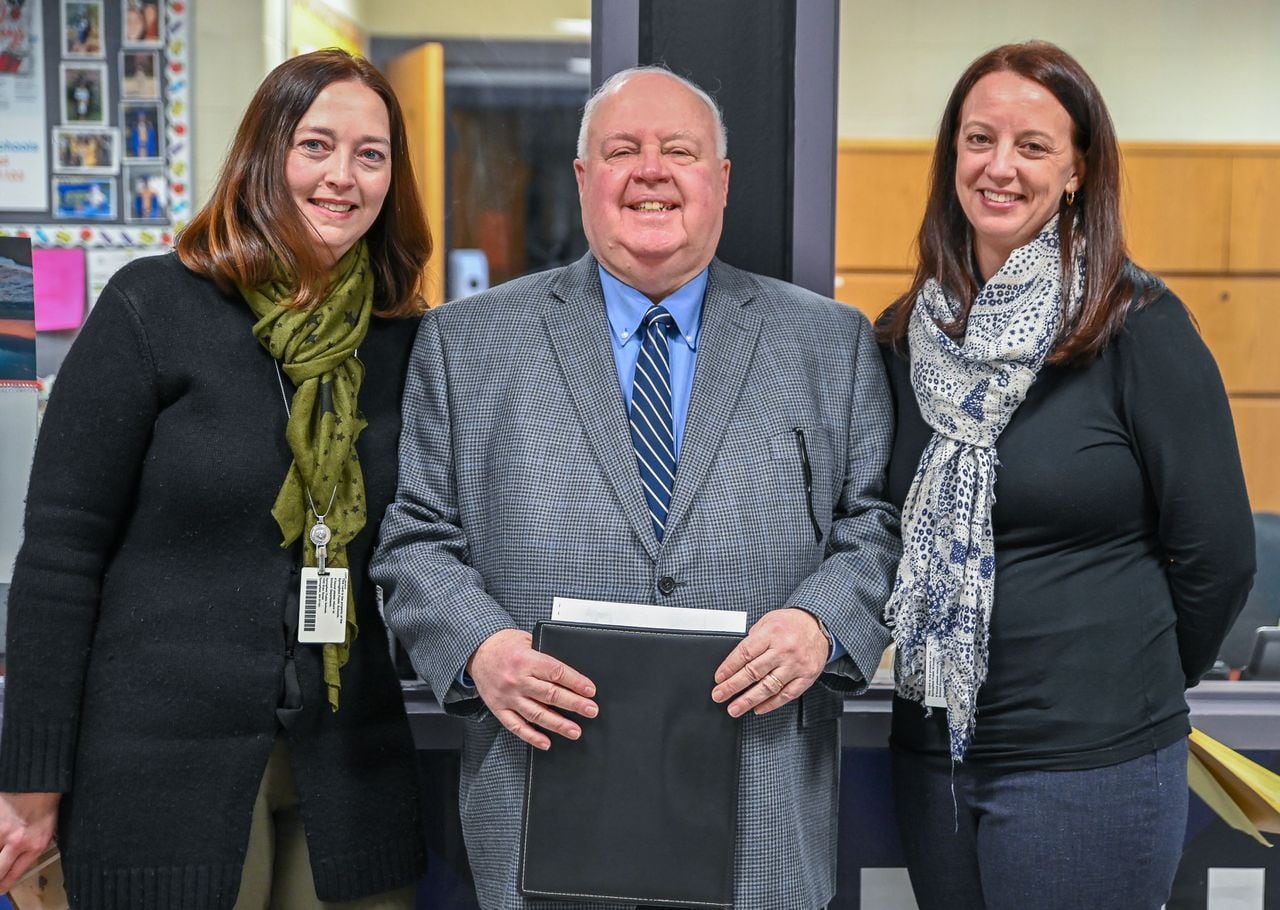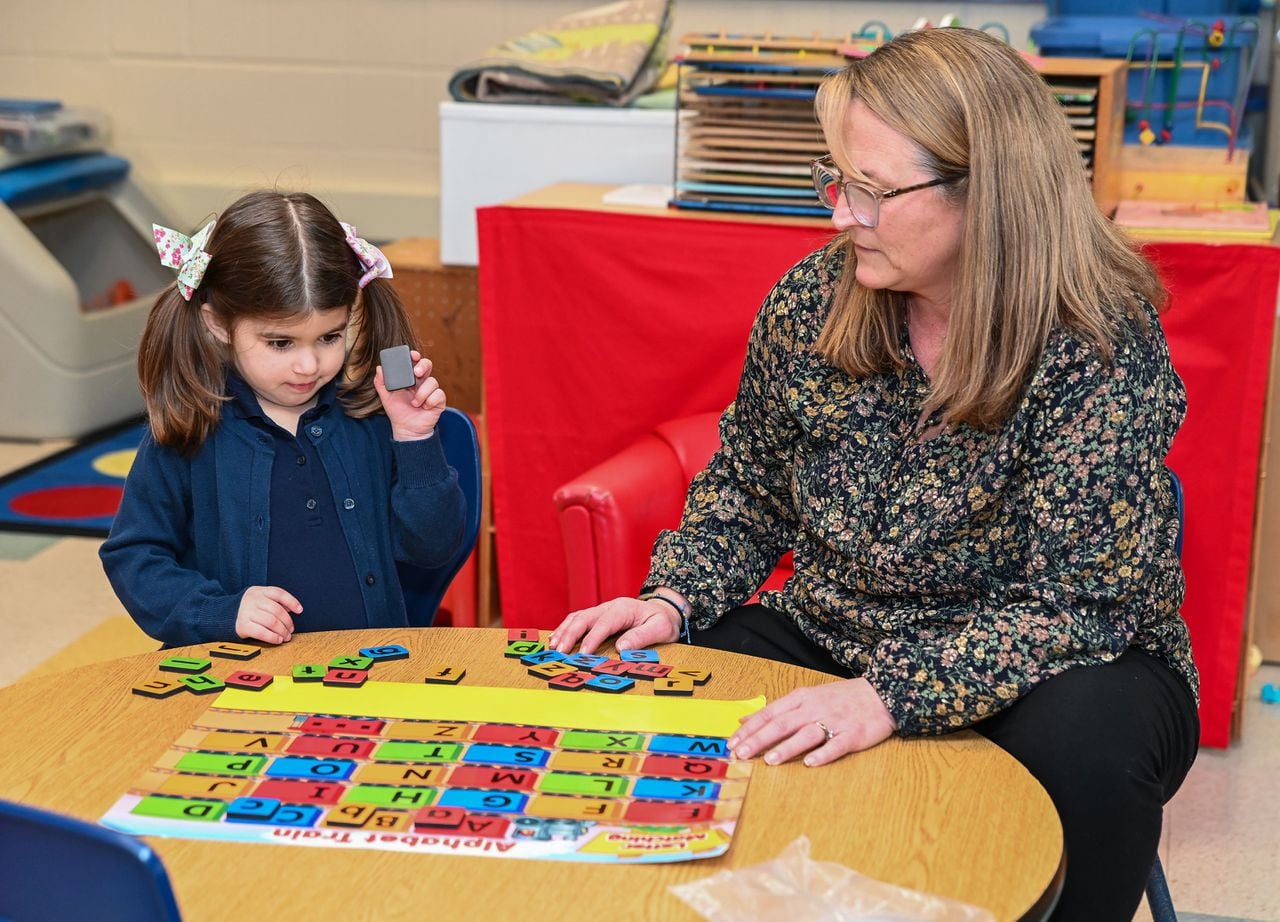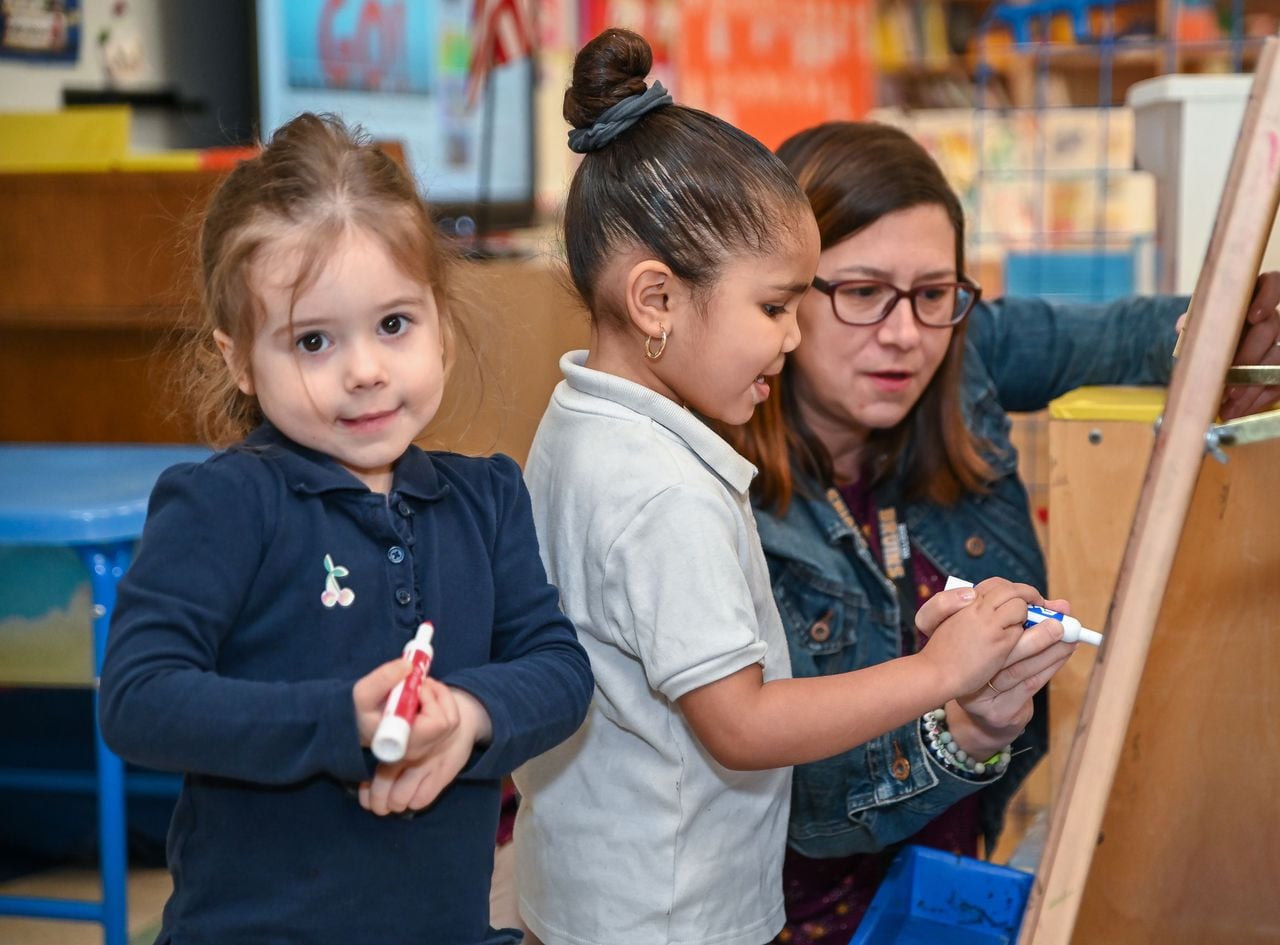SPRINGFIELD — Literacy Coach Lori Kyle uncapped a blue marker and held one of her 3-year-old pupil’s hands as they traced out her name, S-O-U-L-E-I-R-Y, on a whiteboard.
Across the room, a pair of 4-year-olds a treasure hunt searched for plastic letters in a bin of rice.
Those activities at Frederick Harris Elementary School, plus story times, singing, coloring, art projects and more are beginning to pay dividends now that children in the city’s first full-day, free preschool classes are in kindergarten.
Study after study shows children, especially those in high-poverty districts, fare much better in school if they have the opportunity to attend a high-quality preschool.
“We know it will be a game-changer,” Superintendent Daniel Warwick said. “There is no downside for the kids. The kids are the winners here.”
Springfield has long offered preschool for 3- and 4-year-olds, but most of the classes were 2.5-hour, half-day classes with a waiting list in some places. Last year, educators made major investments in the youngest children in the city, opening full-day preschool at no charge to every single child.
The city is the first in the state to offer free, full-day preschool in all of its 32 elementary schools. Warwick says the program is vital in a district with an 85% poverty rate. That nearly ties it with Holyoke and Lawrence for having the most low-income children of any state school system.

Three preschool boys play with tablets in pre-school class at Franklin Harris School in Springfield on Thursday. (Steven E. Nanton photo)Steven Nanton
New tests show gains
When educators tested kindergarten children this year, they found 65% of those who had attended a Springfield Public Schools preschool at least 160 days during 2022-2023 were on or above the benchmarks needed to learn. Among those who did not attend the city’s classes, the number at or above benchmark was 57%, said Laura Mendes, director of literacy.
One of the most significant results: Children who attended the city’s preschool are doing better than those who attended a private preschool — or no preschool at all.
Of those who had no preschool, 34% tested well below the benchmark and 17% tested below benchmark. Among those who attended Springfield Public Schools classes, 19% tested well below and 15% tested below. Children in private preschools were in the middle, with 23% testing well below and 16% testing below the benchmark.

Staff
Kathleen Demetrion, a special education interventionist, said she has seen a difference with kindergarteners at Frederick Harris School this year. Children are simply more ready to learn. Their social interactions, behavior and social-emotional development are all better than they were last year, she said.
“I see more kindness and empathy, more turn-taking and sharing,” Demetrion said. “They already know how to interact with peers and form peer relationships and have meaningful relationships with adults.”
Children who haven’t attended preschool in Springfield often have limited exposure to their own peers and adults outside of their relatives. Preschool gives children a chance to learn how to interact with a teacher and make friends with new people, she said.
A better foundation
Academically, the kindergarteners may not know all their letters and numbers yet, but have a foundation, having been exposed to more, including high-quality literature and the world beyond their neighborhood, Demetrion said.
One big goal is exposing children to rich literacy experiences. Children this year came to kindergarten with a larger vocabulary, which makes learning to read easier. They also have picked up pre-reading skills, like understanding that letters have a sound, Demetrion said.
She lives near Harris School and her 3-year-old started attending preschool there this year. While her daughter has the advantage of having a mom as a teacher, Demetrion said she is seeing great advantages of sending her child to preschool. Her daughter recently came home excited to talk about living and non-living things, the topic of a lesson.
Preschoolers are having fun while learning, as well as being academically prepared, Demetrion said.
“They come to kindergarten ready to learn and excited to learn because they have had a positive experience already in pre-k,” she said.

Springfield Public Schools Superintendent Daniel Warwick is flanked by Franklin Harris School Principal Kara Harris, left, and Chief Schools Officer Shannon Collins. (Steven E. Nanton photo)Steven E. Nanton
Kara L. Harris, principal of Frederick Harris School, sees many advantages to children being able to attend kindergarten right where they attended preschool.
All classrooms, from preschool through fifth, follow the same basic routines. Children spend most days rotating through small-group learning centers. They may work with a teacher, with other students or independently, she said.
Since preschools also follow the center structure, when those children hit kindergarten, they are familiar with the idea. Teachers spend less time introducing school rules and routines. There is little separation anxiety, since children are used to their parents dropping them off for the day, Harris said.
“I love that preschoolers are learning with us,” Harris said.
Building language
Along with the social, emotional and behavioral skills children also come with a lot of pre-reading and numeracy skills. In some cases, children who did not attend preschool, and have never been read to, can’t identify any letters. They spend years catching up with peers — and some never do.
Preschool also helps children who may have learning disabilities or developmental delays get early help, said Shannon Collins, chief of schools officer for zone 2. That provides tools to be successful in school.
Other children in preschool thrive and start kindergarten already reading, Collins said.
“You have to be prepared for kids who are reading too,” she said. All educators adjust their teaching to advance children whatever their skills.
The preschool classes are diverse, with most combining 3 and 4-year-olds. Some children don’t speak English or have limited English. Classes are generally 15 to 20 children to a teacher and a teaching assistant. Smaller classes usually have more children with higher needs who need more one-on-one attention, Collins said.
In Karen Cleavall’s preschool class at Harris School, there is a wide mix of children. Some have the developmental age of a 1-year-old. Others are advanced beyond a 5-year-old.

Preschool teacher Karen Cleavall works with pupil Willa Tomchik, 4, at Franklin Harris School in Springfield on Thursday. (Steven E. Nanton photo)Steven E. Nanton
The mix works because those who act younger learn from their more advanced peers as well as teachers. For example, if two children are at a rice table and the more advanced one is searching for letters, they will announce having discovered an “S” and show it to their younger peer, she said.
“At this level, the most important thing is language building,” Cleavall said. “The learning growth is so great. It is great to see the social and emotional growth.”
In Springfield, nearly 29% of children do not speak English as a first language and 17% are considered English Language Learners who may speak little or no English. Because it is easier to learn language at a young age, those children especially benefit from preschool.
“I have kids who come in and they don’t speak English at all. By the time they are five, they are speaking English better than their first language,” Cleavall said.
She enjoys using different ways to teach children.
Just recently, during a lesson on “The Three Little Pigs,” she branched out and exposed children to connected concepts.
Like Harris, she supports having children attend preschool in their neighborhood school. It fosters communication among staff. She can walk down the hall and chat with a child’s teacher from the previous year.
That builds community. Recently, one of her preschooler’s brothers, now in first grade, came into her classroom and read a book to her pupils.
“He was reading to them and they were really impressed by that,” she said.
Challenges ahead
Creating the universal, full-day, free preschool program wasn’t easy. Work remains, Warwick said. One challenge is finding space and staff.
A declining enrollment helped provide room for preschoolers. But there are schools in Springfield where one more classroom can’t be shoehorned in. When that happens, the schools prioritize putting the 4-year-olds in their neighborhood schools, so they can have that easy transition to kindergarten. The 3-year-olds attend preschool in one of three early education centers, Warwick said.
They created the program during a teacher shortage, adding to the difficulty, he said.
Funding has come from various sources, including state Student Opportunity Act money that boosts programs in schools with the highest needs. The schools used some federal pandemic recovery grants, known as ESSER money, and trimmed other things in the budget.
“We feel it was money well spent. It was so important for our kids,” Warwick said.
Now in its second year, the program is expanding. When preschool classes were half days, about 600 children attended. Now, there are 2,000. Warwick would like to see far more than that. He hopes through recruiting and word of mouth, more families will find out about it and participate.
Eliminating the barrier of cost and running on a regular school schedule has made a big difference.
One of the changes teachers saw almost immediately: Preschool attendance improved dramatically, because parents were no longer juggling to find ways to drop off or pick up kids after 2.5 hours, Harris said.
No one is sure how many preschoolers are not taking part. But there are about 1,600 children each in kindergarten and first grade, so there are likely more than 3,000 3- and 4-year-olds eligible for school this year.
Most of the increase in children attending preschool this year came from those families that had not attended any early childhood education program. Warwick said that is a positive development, since those children score lowest on kindergarten readiness evaluations.
Though he will retire at the end of the school year, Warwick said he’ll be watching from the sidelines to see how the expanded preschool program helps the city reach its goal of having every child able to read fluently by third grade.
Warwick calls this the “most significant” thing achieved in his 48-year career.

Literacy Coach Lori Kyle works with Souleiry Gomez, 3, center, and Quinn Lessard, 3, in the pre-school class at Franklin Harris School in Springfield on Thursday. (Steven E. Nanton photo)Steven E. Nanton





